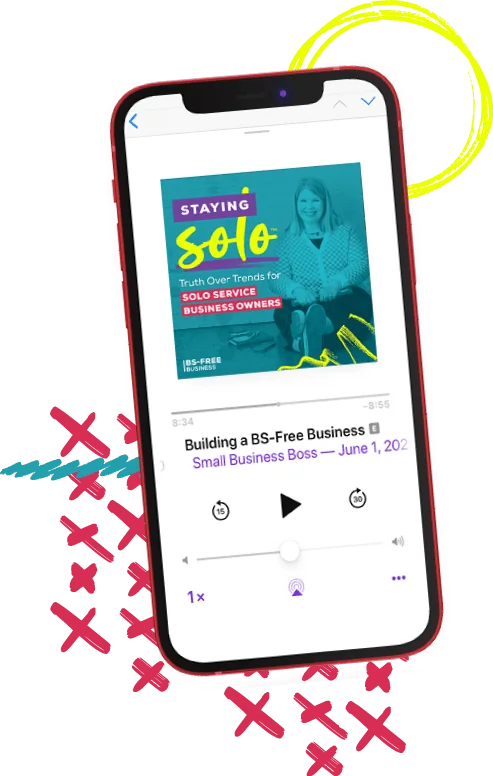
Search the site:
Creating Your Ideal Week When You Work With Clients
The reality of working with clients means, for many of us, that the work we need to do to maintain or grow our business is last on the list. We spend so much time working IN the business that we don’t have any time left to work ON the business. But it doesn’t have to be this way. By creating your ideal week and taking control of your schedule, you can carve out time to work ON the business and not just IN it.
For years, in my business, I was so busy with client work that things like accounting, marketing, and new business development didn’t get the attention they needed. And it’s no surprise that for many years while this was going on, my growth was relatively flat.
Eventually, only working for clients and focusing on their needs will catch up with you. It may be that you’re not able to meet your goals or that you’re on the road to burn out.
In my case, because I was only really working IN my business, my ability to find new clients was completely reliant on my existing clients being willing to refer me or my industry connections helping me. Plus, anything that wasn’t essential didn’t get done. Things like asking for testimonials or referrals, spending time networking, or even thinking about my long-term strategy were always being put off for “later.”
If this sounds like you, I want you to know this is a common challenge when it comes to running a services-based business. And with good reason — you’re following the money and doing client work to grow your business. But you don’t want to do this to the detriment of your future growth. A certain baseline of vision, strategy and working ON your business needs to happen.
Here are three specific ways — starting with creating your ideal week — to help you carve out time every week to work ON the business:
1. CREATE YOUR IDEAL WEEK
It took me a while to learn this, but if you don’t schedule time to work on the business, it will never happen. Your client work will fill in every available time slot on your calendar.
That’s why you need an ideal week. You need to take control and not let your inbox and task list takeover.
Start by getting clear on what your work hours are and what life or personal commitments you have each week. Those should go into your calendar first so they’re scheduled, and you’re making them a priority.
After that, you need to put in a block of time for you to work ON your business. Ideally, you can add multiple blocks during the week.
Before you object and think “Noooooo, I can’t do that!” I encourage you to give it a try. It’s going to feel hard at first, but you need to remember that you are the boss and that your clients don’t need to have 24/7 access to you. So, if you take Monday afternoons for your business priorities, it’s factual.
As you’re looking at time blocks for working on the business, think about what specific things need to be done weekly, monthly, or quarterly, and add those into your calendar.
Only after you have those time blocks in place should you slot in your client work. Working ON the business should go first!
2. DETERMINE TASKS FOR YOUR TIME BLOCKS
Having a few hours in your week — or even a full day — to work on your business is going to feel a bit like a luxury. What you absolutely need to do is spend time before that time block getting clear on what needs to happen.
The last thing you should do is sit down for your time block and think, “Okay, what is it I’m doing again?” Because in that case, you’re going to end up distracted, scrolling Facebook or deciding to take the afternoon off.
To help keep me focused during these blocks of time, I have an internal project in our project management system Basecamp 2 where I keep a running list of what I need to focus on during those time blocks.
When it’s time, I sit down with that list to guide me, and I’m able to maximize my non-client focused time.
This approach also helps me not get sidetracked when working on client work. If I have an idea or thought of something I can do for the business, it goes into the project in Basecamp.
3. SET BOUNDARIES FOR CLIENTS AND WITH YOURSELF
If you work with clients, boundaries are everything. Yet, they’re hard for most of us.
We work with clients because we want to help. But don’t confuse being a service owner with having to serve people around the clock. You don’t need to respond to every email within minutes or consistently sacrifice the time designated to work on your business.
If you’re struggling with client boundaries, I challenge you to look at why you have a hard time saying no to your clients. Many times, it has nothing to do with the client and their behavior and everything to do with us being scared, fearful, or passive. Most clients are incredibly reasonable, and it’s up to us to set expectations and manage them.
You can have happy clients and maintain strong boundaries. With new clients, ensure you outline how you work, including things like your office hours, turnaround times, deadlines, response times for emails and so on. Include these items in your proposals and contracts, so you’re starting from a place of understanding.
With existing clients, putting those boundaries in place can be a bit more challenging, as you’ve likely fallen into some bad habits. It may be a matter of you not responding to every email immediately, enforcing your work hours, or even doing a reset with the client on expectations. Start with little things, and over time, you can re-establish a working relationship that works for you as you don’t feel like your client is your boss.
A big part of being able to be successful with your ideal week is sticking to your plan. That means when you have time set aside to work on your business, you don’t start doing client work or responding to emails or taking a client call during that time block. You need to treat that time as sacred.
You don’t have to tell clients you’re unavailable or make a big deal about it; just keep it factual that for that particular time, you’re already booked. If you’re not available on Mondays from 10 a.m. to 2 p.m. as that’s your dedicated time block, your clients don’t need to know WHY you’re not available, just that you’re not.
Finally, if you feel stuck because something comes up during that time block and your boundaries are feeling tested, offer an alternative. Instead of saying no, propose another time that does work for you. It can be as simple as, “Hey, Client, I actually have something scheduled at that time. Would 3:30 p.m. work for you instead?”
Creating your ideal week, making it productive, and sticking with it will take some practice, but I promise you, if you do this and truly make it a priority for you, it will pay off.

I’m Maggie Patterson (she/her), and services businesses are my business.
I have 20+ years of experience with client services, am a consultant for agency owners, creatives, and consultants, and vocal advocate for humane business practices rooted in empathy, respect, and trust.
Read or Listen to the Latest
Check Out These Posts
For Solo Business Owners

Growing a solo service business is tough.
It’s even harder when you’re bombarded with BS advice that steers you away from your values and why you started your business in the first place.
This is the podcast for solo creatives and consultants who want to remain as a team of one and have zero interest in the hustle and grind of typical business teachings.
Subscribe now and never miss an episode.
For Micro Agency Owners
Most podcasts for agency owners obsess over revenue growth as the ultimate success metric.

But here’s the truth: not everyone wants to make millions. Your goal might be to build a sustainable business that lets you have a life and doesn’t run you into the ground.
Join me as I spill my shameless confessions and share everything I’ve learned about building a micro agency that skips the BS of tired and typical agency teachings.
Follow Now on All Major Podcast Platforms








